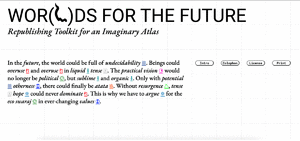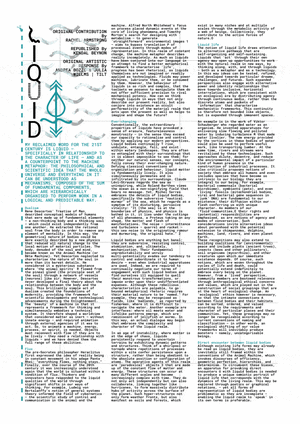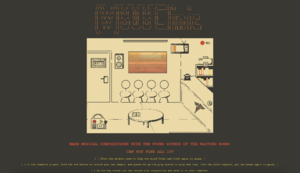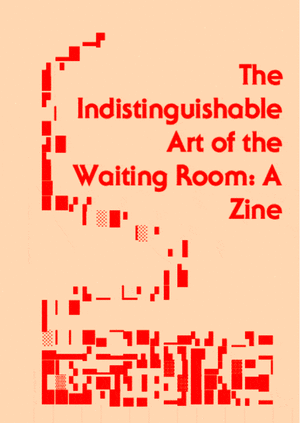User:Kendal/Final presentation
Final Presentation
First Year
Special Issue · 1
URL: https://issue.xpub.nl/13/LIQUID/
Wor(l)ds for the Future
Republishing Tool Kit for an Imaginary Atlas
Words have the power to shape reality. Wor(l)ds for the Future is a set of map-making tools to re-imagine and collect wor(l)ds, and to re-publish an everchanging atlas. We invite you to delve into the materials and traverse the texts in any way you desire: by cutting and pasting the printed matter, or by unravelling the texts online. The choice is yours. You can reconstruct images and reinterpret words to create Wor(l)ds for the Future.
This project is a republication of Words for the Future (2018), a multivoiced series of ten booklets. In the 2020 version, we reinterpreted the original material through methods such as annotating and prototyping in Python (a coding language we used to analyse text as texture). The ten booklets were cross-examined and mapped in order to find interconnections and links.
Main focus on feedback loops, flux, flow and text as a regenerative organism.
OBSERVATION: Information inside a boundless space. TOOLS: ASCII (AALIB), NLTK & PDFTK Stamp / Background GOAL: Ascii texture made from texts, layering and feedback loops,
"Living text that is boundless & loops"
For my individual contribution, I was taken by the idea of feedback loops, flux, flow and text as a regenerative organism. Through Prototyping sessions, I felt that python tools such as ASCII & specifically NLTK could be used to reinforce the ideas of the flow from text to image, from output to input. My resulting pages aimed to show the looping of texts within the essay and how these can be looked at in a liquid way, settling on the ASCII representation of text flowing into itself replicating the movements of a waterfall. My end result highlights the revisiting of information but applying new methods and experiencing new forms, an idea explored in the original Liquid text.
ROLES
- Print Production
- Copy Editing
- Contextual Team
Special Issue · 2
URL: https://hub.xpub.nl/sandbot/PrototypingTimes/HOTSPOTS/5%20pigeonplaza/appointment/
Together we created an open city game using an unfinished Situationist International as a starting point.
I Don’t Know Where We’re Going But… is a local networked city quest based in The Hague.
During the course of this semester, we tried to imagine what the seventh issue of the Situationist Times could be if it were produced today. This resulted in a series of works located in hotspots installed throughout The Hague. The game involved a series of coordinates that invites the player into a psychogeographical exploration of this distributed publication.
W808 & other materials
I created a game that explores the affordance possibilities of a waiting room. Gamify the non-place, what can you do with sparsely scattered interiors of transitory space? Non-places seem to be the absolute thing situationists want to avoid. The idea of a place so bound by rules yet devoid of humanity and play is fascinating to me because they're so easy to identify and we spend a lot of time in these places. Given this, I want to take the mundane aspects of a waiting room, and use them as ingredients to create a performative use of space in an attempt to suggest what a situationist non-place could be.
In regards to gameplay, this translates to using found ambient sounds to create a disruptive soundtrack of a space. Taking recognisable clips, we can redefine the meaning and purpose of this atmosphere as a jumping-off point for creativity and play.
A deep dive into trying to replicate the audio of psychogeography, the ability to manipulate these sounds and play with things that shouldn't necessarily be played with. More precisely, it's the performative use of space in a non place. The idea of what a situationist non-place could be. It's taking the mundane 'givens' of the waiting room and using them as ingredients to create.
[W808]
Screen Capture of entering the game from the launch page
Special Issue · 3
URL: https://issue.xpub.nl/15/index.html
A Oracle Hijacking
https://hub.xpub.nl/sandbot/~kendalb/SI15/notes.html
"Hidden Worlds of Digital Voices An exploration into the invalidated, hidden and rejected data and where it resides In a virtual space of multitudes of data, what happens to the pieces which fail to be accepted?
Throughout the broadcasting timeframe, I want to construct a virtual world that gives life and a voice to the hidden and undefined.
Inspired by projects from Mimi Onuoha, I am interested in giving space to the missing and their significance to "successful" datasets."
The Department of Oracle Hijackings ❃ A routine call to the XPUB Department of Digital Records gets interrupted by a disgruntled employee who has begun to become critical of her workplace's structures and wants to expose the gaps between.
A live stream from the garden in Ijzerblock, A collection of previous broadcasts with the whole storyline revealed Final broadcast. Putting all the pieces together, a mystical symbiosis. Live card readings. Create the story of the worker from the call centre of the second week. We call the number, and are led through previous broadcasts until we choose 'tech apology letters'. At this point, the operator hijacks the call to use The Hidden Oracle, a passion project born from the injustices she found at work. This is where we do the live reading with someone who has heard through the grapevine that she provides these readings, and together we break down a Facebook apology.
Second Year
From previous projects, exploring physical non-spaces, the concept of affordance, then moving into the hidden and forgotten in SI15. Standardisation of the internet.
Research Thesis
3 chapters, Utopias, Ruins & Playgrounds.
Utopias represent the chapter based on standardisation of the web and how utopia comes into play when designing space both online & offline
Ruins looks at how internet decay comes to be and how spaces fall into the role of a digital non place.
Playgrounds is the final section which looks at the history of virtual worlds and tries to find a new way to inhabit these spaces so not everything falls into disarray.
Motivation
Abandoned and underpopulated online platforms tell us the stories of a forgotten past & future.
During the pandemic, a large number of 3D virtual environments were constructed as a way to connect people in a time of isolation. However, when viewing these spaces, I noticed a stark difference between these worlds and the worlds I would inhabit in the early years of the internet. It led me down a path of how and why this changed, and while exploring I also began to notice parallels of the promises made in physical space which also result in a series of forgotten wastelands.
Aquarium
Aquarium 1.0, architectural model making prototypes, used in a workshop where we try to imagine what to do in these spaces given their background.
Aquarium 2.0, locating these spaces online (YWoT, Habbo Hotel & Space Hey) linking them with quotes related to internet decay, zombie media, and traces of inhabitation.
Goal was to give visibility back to these platforms.
Overall prototyping for this project has been about playing with form and involving communities either through workshops or by introducing new communities to existing ones.
URL: https://pzwiki.wdka.nl/mediadesign/User:Kendal/Aquarium
Virtual Gardens
I'm creating a simulated desktop interface of a therapist for users to 'sneak' onto to uncover research and hidden files.
The idea is to give visibility to these platforms and communities and offer an alternative landscape online.
PROJECT PAGE: https://project.xpub.nl/virtualgarden/
DIRECT URL: https://hub.xpub.nl/sandbot/~kendalb/GardenOS/?#
Interviews
Conducting interviews with Kyle Drake (Neocities), Preserving Worlds , SpaceHey, Sadness (Yesterweb server) & Mariana Marangoni (artist) Inside the OS to make the interviews more conversational, I'm implementing them into a Chatbot that replicates a group chat reminiscent of early web experiences as a teenager
find them here:
Interviewing Yesterweb Community
Website - https://yesterweb.org/
Interview - https://pad.xpub.nl/p/yesterwebinterview
Interviewing Preserving Worlds
Website - https://preservingworlds.net/
Interview - https://pad.xpub.nl/p/Preservingworlds_interview
Interviewing Spacehey
Website - https://spacehey.com/
Interview - https://pad.xpub.nl/p/spaceheyinterview
Interviewing Restorativland & Neocities
Website - https://restorativland.org/ & https://neocities.org/
Interview - https://pad.xpub.nl/p/kyledrakeinterview
Interviewing Mariana Marangoni
Website - https://marianamarangoni.com/
Transcribed interview - https://pad.xpub.nl/p/Marianamarangoni-conversation
Features of OS
- Chatbot group chat
- Patient files telling stories of online experiences
- Folder of 'retreats' - 3 platforms to retreat as treatment
- Thesis as research
- Virtual Memories Guestbook: Find it here - https://hub.xpub.nl/sandbot/~kendalb/BureauofForgottenFutures/virtualmemories.php
- Webring links to each platform
- Therapeutic affirmations script to show it as a therapists' computer.
- Alternative web search engine
- Recycle bin with easter eggs (hidden files)
- Raw text files of interviews with specific people related to this world.
Tools
HTML/CSS/Jquery
Pamphlets
For each space I am working with (Yesterweb, SpaceHey & Neocities) I am designing a retreat-style pamphlet often found in therapy waiting rooms advertising their therapeutic benefits.
Onboarding in the Virtual Garden Workshop
In groups of 2, I will be onboarding users to three hidden spaces and, together, we will rediscover the magic of being online and a part of a creative community. Each participant will leave the workshop with an alternative webspace to cultivate and retreat to, along with some history of forgotten virtual spaces.
Future
Exhibition & Publication
For the exhibition, I will simulate a therapist's office into an installation. This will feature a couch, desk with a retro computer, motivational posters, and various printed materials scattered about the room.
Taking cues from escape rooms, materials will be strategically placed for visitors to 'stumble upon' to uncover the hidden stories of online experience and to dive into the various research methods of this project.
My contribution to the collective publication will be a written tutorial of the onboarding workshop I will give at the exhibition, welcoming visitors into the alternative spaces and giving a brief history of the web as a creative space for expression,




